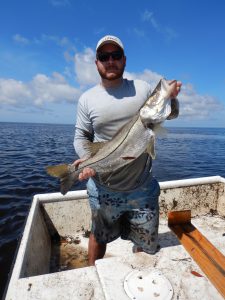Written by 2019 Summer Intern Shea Husband, with host Caleb Purtlebaugh from Florida Fish and Wildlife Conservation Commission

Introduction
My name is Shea Husband and this summer I worked with Florida Fish and Wildlife’s Fisheries Independent Monitoring (FIM) team under Caleb Purtlebaugh through UF/IFAS’s Nature Coast Biological Station’s summer internship program. Through this incredible opportunity, I was able to work in the field and lab and gain firsthand experience in fisheries science, and I will use this experience to focus my future studies towards a career path in marine sciences.
Field Experience
Most of the fieldwork I did was part of FIM’s ongoing monthly inshore sampling efforts that use stratified random sampling to gather fisheries data on coastal estuarine areas in Cedar Key, Suwannee, Steinhatchee, and Econfina. The sampling done in these areas uses a variety of techniques using 600’ seines, 70’ seines, and otter trawls.
I also got the chance to help with a collaborative project between FWC/FIM and UF’s Mike Allen looking at the movement of common snook (Centropomus undecimalis) around the Nature Coast. These days were quite different from the normal FIM sampling and gave me the opportunity to try electrofishing for the first time, and some hook and line sampling. The snook we caught were then tagged and can now be tracked using receivers we have installed throughout the Nature Coast, I also helped locate and download these sensors as well as help in the installation of a new sensor.
 Lab Experience
Lab Experience
During lab days I helped with data entry, fish workup and fish identification in the lab. All of FIM’s data is reviewed, entered, and then proofed by different people for accuracy to make sure all the data we collect is as accurate as possible. In the wet lab we would work up certain species of fish that we collected in the field and take tissue samples for mercury content, otoliths for aging, stomachs for diet analysis, and gonads in some species. Whenever we are in the field we collect a representative sample to make sure our field IDs are accurate. We work these samples up in the lab using microscopes and an assortment of literature to refer and verify accurate identification using different techniques such as fin ray counts, chin pore counts, coloration, body shape, etc.

Acknowledgments
First and foremost I want to thank the kind and hardworking team at FIM for teaching me so much about different fish and for making this internship an incredibly enjoyable experience, there is no one else I’d rather spend my day pulling nets, through knee-deep mud full of oysters and stingrays, with. Thank you; Stephanie, Chelsea, Matt, Johnny, Brian, Will, Laura, Lizzie, Taj, and Caleb. I’d also like to thank UF/IFAS and the Nature Coast Biological Station for providing this opportunity.
 1
1
